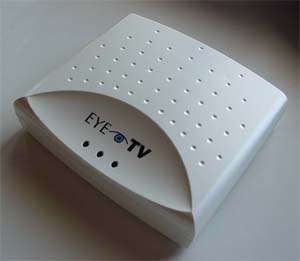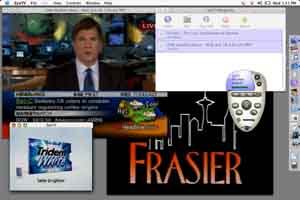 |
 |
Home > Reviews > EyeTV
The Digital Hub Gets a New Spoke: Television
by Jim Heid
Ask me about my TiVo. You'll get the same answer that anyone with a personal video recorder will give you: It changed my life. A PVR frees you from the tyranny of TV schedules. Record a show and then watch it whenever you like. Pause live TV to answer the phone or replenish your Mountain Dew. Go back and watch that game-winning play again. Commercials? You don't have to watch them unless you want to.
A PVR is a computer: shows are digitized into MPEG format and stored on an internal hard drive. (Indeed, TiVo units contain PowerPC microprocessors and run Linux.) Realizing that a lot of people already own boxes containing microprocessors and hard drives, several companies have long offered hardware and software bundles that turn a PC into a PVR.
When I reviewed these products for the Los Angeles Times earlier this year, I found none were available for the Mac. That's about to change. At the Macworld Expo next Wednesday, El Gato Software, the developers of Roxio's Toast CD-burning software, will introduce EyeTV, a $199 hardware-software bundle that turns any Mac running Mac OS X into a PVR.
I tested a prerelease version of the EyeTV system and was impressed with its capabilities and elegant design. EyeTV provides most of the essential PVR features and adds some goodies, such as the ability to burn shows to a VideoCD. EyeTV isn't going to replace the TiVo in my living room, but it will definitely supplement it. In fact, depending on your budget and viewing needs, EyeTV may be all the PVR you need.
|
|
The Hardware
The hardware half of EyeTV is a small box that connects to one of the
USB ports on your Mac. The box contains a cable-ready TV tuner and circuitry
that compresses video into MPEG-1 format for storage on your Mac's hard
drive.
Many Windows-based PVR products put their tuners on circuit boards that install inside the computer. EyeTV's external approach enables it to work with iMacs, iBooks, and PowerBooks. And it makes your PVR portable: toss the EyeTV box into your suitcase, and you can record shows on the road. (If you just want to watch recorded shows on the road, leave the box at home -- it isn't required to watch recorded shows.)
The back of the EyeTV box contains a coaxial cable jack that connects to standard cable TV line or antenna. There's also a separate composite video input and stereo audio line inputs. I used these to connect the EyeTV box to my DirecTV satellite receiver. I also used them to record images from my digital camera's video output.
The EyeTV box doesn't require a power supply; it draws juice from the Mac's USB port. You can also connect it to a powered USB hub.
The Software (and Web Site)
The EyeTV software is what turns this box and your Mac into a PVR. You use the software to tune in and watch shows, record them, and watch and work with shows you've already recorded.
Start by using the Auto Tune feature to configure the software and tuner to recognize the stations you receive. Next, fire up your Web browser and register with TitanTV, an online TV scheduling site that Windows-based PVR products also use.
TitanTV provides much of the scheduling smarts for EyeTV. You use your browser to see what's on, to set up automatic recording of shows, and to search for upcoming shows that meet various criteria. An icon appears next to each upcoming show in TitanTV's programming grid. Click it, and the EyeTV software is automatically configured to record that program.
You can also manually configure EyeTV's software to record shows. The New Schedule Info dialog box lets you specify repeat recordings (either daily or weekly) as well as the quality setting for the recording.
Of Quality and Disk Space
Speaking of quality, the EyeTV software lets you record at either of two
quality levels. At "standard" quality, shows are recorded at
a data rate of about 172kbps per second; an hour of video uses about 650MB
of disk space. Video quality is roughly analogous to that of VHS videocassette—which
means it falls short of the quality you get from hardware PVRs such as
TiVo.
You can also choose a high-quality recording mode, which provides about twice the resolution (and uses about twice the disk space). But shows recorded at the high-quality setting can't be burned in VideoCD format.
You can export a recorded show as a QuickTime movie. When you do, you get an MPEG-1-format movie whose pixel dimensions are 320 by 240 pixels. You can copy that movie into Roxio's Toast Titanium software and burn it in VideoCD format. Most current DVD players can play VideoCDs.
Watch This
Most of the time, though, you'll use the EyeTV software to watch recorded
shows or live TV. Programs you've recorded appear in the EyeTV Programs
window—it's roughly equivalent to TiVo's Now Playing screen. Double-click
a show, and it begins playing in its own window. As with Apple's DVD Player
software, you can choose from several window sizes, ranging from a small
thumbnail size to full-screen.
 |
You can play back a show while recording another, and even play back several shows at once. In the screen shown here, I'm playing back two recorded shows while simultaneously watching live TV. You hear the sound of only the front-most show.
EyeTV wouldn't be a PVR if it didn't allow you to pause and scan forward and backward within a show. You can use the software's on-screen remote control, called the Controller, for these tasks, or you can use the commands or keyboard shortcuts in the Controls menu.
With the jump button, you can skip forward in 30-second increments: perfect for skipping commercials, even if doing so makes you a thief in the eyes of Turner Broadcasting CEO Jamie Kellner. The instant replay button jumps back seven seconds, while the forward and review buttons play forward or backward at double speed.
|
The Missing Captions
The EyeTV software has one omission that competing Windows products provide:
the ability to display closed captions. Closed captions are obviously
valuable for hearing-impaired viewers, but they're useful in other scenarios,
too. For example, a business person monitoring CNBC (or "All My Children")
in a small window might keep the program's audio muted, relying instead
on the closed-captions.
And on the Windows side, ATI's PVR products can extract the closed captions and save them in a text file—handy for creating transcripts of news programs, not to mention episodes of The Simpsons.
El Gato Software plans to add closed-caption support to a future release of the EyeTV software.
No TiVo Killer, But Way Cool
No personal computer-based PVR product can compete with the ease of use
and all-in-one convenience of a dedicated PVR such as TiVo. Computer-based
PVRs require a separate Web connection for the program guide, the shows
they record devour hard drive space, and the devices are difficult if
not impossible to connect to a television set.
But they still have their place. EyeTV is ideal for a space-starved college dorm room, and it's a perfect "spare TV" for any household. It's well suited to business users who want to catch the news (or the soaps) while at work. EyeTV is also a less-expensive alternative to a dedicated PVR—it not only costs less to begin with, but there are no "activation fees" or monthly subscriber fees to pay.
EyeTV is also a dream for PowerBook or iBook users who want to record shows and then watch them on the road. I'll be doing exactly that next week as I head for New York's Macworld Expo. In fact, if you're on America Airlines flight 258 on Wednesday, look for me— I'll be the guy watching The Simpsons on my PowerBook G4.
Like this review? There's more to come, but for members only. Learn about "The Macintosh Digital Hub," a first-of-its-kind book and DVD hybrid, and find out how to join the hub.
Home > Reviews > EyeTV
[counter: 'hub_eyetv']


